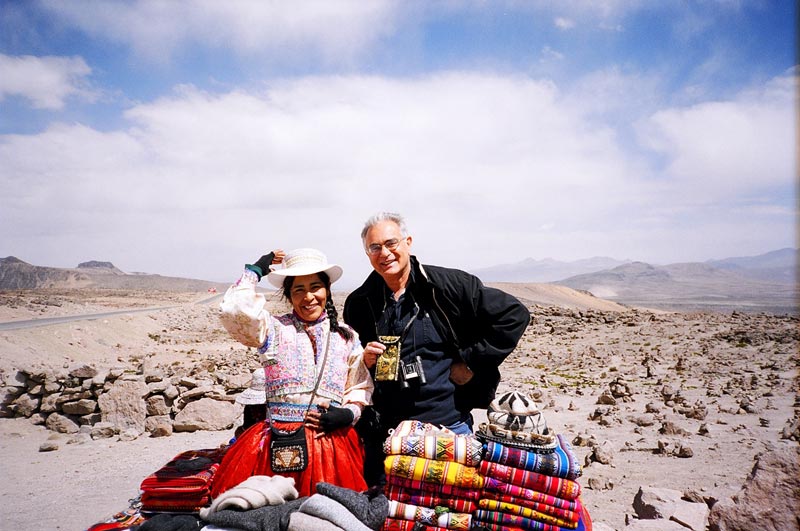Chivay: "Altiplano"
Day One
Arequipa to Chivay
November 25, 2003
Dear Family and Friends,
Say “Hello” to Enrique, my tour guide, and Felix, my driver.
My small tour group is bound for Chivay and the Colca Canyon, by minivan.
The group consists of a young married couple from Spain, a younger, soon-to-be married couple from Peru, a young man from Japan and a young man from Germany. Yes, as per usual, I am the senior member of the group. “Señor Juan,” if you please.
Just outside the city we stop for some last minute provisions: bottled water, snacks and the WC. We are off to the high plains desert, volcanoes and the famously deep Colca Canyon.
(By the way, it’s a good thing we stopped for some extra water supplies. After about a half hour on the road, we passed another tourist van on the side of the road. The radiator was steaming. So, we poured in our extra drinking water and everyone was happy. No service stations out here, my friends. Just endless, stark, spectacular desert scenery.)
I have been looking for a way to describe this very special trip to you. I have decided to do it through my own eyes, of course, but also through the eyes of some “professionals.”
OK…So here goes…
Geologists would crawl over and examine the steep, rugged outcrops and the deep, gray, brown ravines that slash through the hills and valleys. And they would marvel at the frequent twisting sandstorms.
Volcanologists would climb the extinct, inactive and active, menacing, yet grand, mile high conical mountains shrouded in a gray mist.
Mammalogists could wander on the flat plains with the grazing herds of domesticated llamas and alpacas. There are wild, endangered, vigorously protected and highly prized vicunas off in the distance. All of them seeking vegetation near the watering holes and small shallow lakes scattered over this otherwise empty expanse.
And don’t forget the gray rabbits, absolutely the same color as the terrain they inhabit. Felix pointed out a few, sitting in the sun, yet completely camouflaged. They appear to be just another large rock amongst larger rocks until they skip away searching for food, whatever that could be.
Ornithologists would sing the praises (sorry) of hummingbirds, Andean geese, blue-coated eagles and flamingoes. Yes, my dear readers, pink flamingoes wading in these desert lakes. Who would have guessed?
Botanists could no doubt solve the thorny question (sorry, again) of the survival of several species of specialized plants and low-lying shrubs. And the strange, shiny, moist blob of a green globe hugging the ground and growing at the rate of 2 cm a year. Yes, of course, a variety of ubiquitous cactus, some growing in multi-armed grandeur towering three or four meters high.
Hydrologists need to dip into the remarkable methods of irrigating these fertile mountainside terraces that have sustained the local population for centuries. How in the world do they manage to have the water go UP?
Civil Engineers can travel the clinging, narrow, mountainside roads built a thousand years ago and used to this day to transport agricultural products.
Agronomists could savor the plentiful variety of corn, potato and peanut – all of which were first cultivated in Peru.
Archeologists would be eager to search for ancient relics, artifacts, temples and sacrificial mummies which still wait to be discovered in the cliffs above the valleys which are being carved by roaring, whitewater, inaccessible rivers that are just being explored by intrepid rafter-scientists.
Anthropologists could huddle with the numerous tribes who follow the ancient folkways and customs. And what’s up with those hats the women wear? It turns out each tribe has its own particular style…colorful, decorated, and practical, considering the hot daytime sun and cold, windy evenings.
And what about those endless small piles of stones decorating the desert floor? Well, my dear philosophical-religious friends, the stones start on the ground and reach up into the air to the heavens. And so we are encouraged to build one (as I did) to ask the gods to grant us good health and prosperity.
And finally, Historians need to explain just how this myriad of indigenous groups survived first, the overpowering, culturally controlling Inca invasion and subjugation, and then the brutish, avaricious Spanish conquest?
These desert and mountain valley areas have been inhabited for centuries. Millennia.
Here are a couple of highlights of the first day of the two-day tour:
* A take-a-stretch stop in the desert at a large shop dispensing coca tea for altitude sickness. Anyway, the scenery was good at this spot.
* Late buffet lunch in Chivay, our destination for the day. The elaborate and colorful buffet included cold salads, hot soups and hot dishes of fish and meat and pasta. I opted for the alpaca stew. (The next day at another restaurant, I tried the alpaca stroganoff. I kid you not!)
* Dinner on the street. Some fried chicken and rice served at a food stall. Just me and the German guy and the local folks from the mountains.
* Evening swim and relaxation at a hot thermal bath spa. Dozens of tourists from everywhere, splashing about in this huge, steaming outdoor pool under a cloudless, starry night sky.
THE highlight of the trip will come tomorrow when we head out to Colca Canon and The Condors.
Off to sleep. Whew. What a day!
Hasta mañana.

